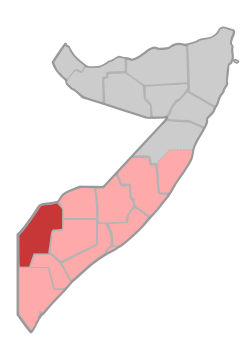
Back جدو Arabic Гедо Bulgarian Gedo Catalan Gobolka Gedo CEB Gedo Czech Geedo Danish Gedo German Gedo Esperanto Región de Gedo Spanish Gedo Basque
Gedo
Gobolka Gedo | |
|---|---|
| Gedo Region of Somalia | |
 Location in Somalia | |
| Coordinates: 2°26′17″N 41°29′3″E / 2.43806°N 41.48417°E | |
| Country | |
| Regional State | |
| Capital | Garbaharey |
| Government | |
| • Governor | Ahmed Bulle Gared |
| Area | |
| • Total | 85,000 km2 (33,000 sq mi) |
| Elevation | 914.4 m (3,000 ft) |
| Population (2019[1]) | |
| • Total | 566,300 |
| • Density | 6.7/km2 (17/sq mi) |
| Time zone | UTC+3 (EAT) |
| HDI (2021) | 0.318[2] low · 9th of 18 |
Gedo (Somali: Gedo, Maay: Gethy, Arabic: جيذو, Italian: Ghedo or Ghedu) is an administrative region (gobol) in Jubaland, southern Somalia. Its regional capital is Garbahaarreey. It was created in 1974[3] and is bordered by the Ogaden in Ethiopia, the North Eastern Province in Kenya, and the Somali regions of Bakool, Bay, Jubbada Dhexe (Middle Juba), and Jubbada Hoose (Lower Juba) further down east. The southern parts of Gedo, west of the Jubba River, used to be part of the old British Trans-Juba region during half of the seventy years of colonial era in Africa from 1890 to 1960. The British and Italians fought twice over this area. The first democratically elected governor of the administrative region was Hussein Farey, who entered office in 2008.[4][5]
The regional capital is Garbaharey. The Marehan (Darod) dominate economically, politically, and militarily, and rule across all districts.
The Marehan in Gedo is split between the guri ('original inhabitants') and the galti ('new settlers').[6] Guri-Galti conflicts over power and resources are common, especially in Luuq, Belet Hawo, and Baardhere.
Garbaharrey was the last refuge of deposed President Mohammed Siad Barre in early 1991, before he left the country for Nairobi and exile.[7] After 1991, the Somali National Front under Marehan Omar Haji Masale held large parts of the region for many years.[8] The militant religious group al-Itihaad al-Islamiya (AIAI) also rose to power in the region later in the 1990s, taking Luuq as its headquarters.[3] The Ethiopian National Defence Force then entered the area to attack AIAI's bases in 1996, and the Marehan clans split, either supporting or opposing the Ethiopian forces.[6] A peace conference to resolve the intra-Marehan disagreements was convened in 2004.
- ^ "Somalia: Subdivision and cities". www.citypopulation.de. Retrieved 2024-02-14.
- ^ "Sub-national HDI - Area Database - Global Data Lab". hdi.globaldatalab.org. Retrieved 2018-09-13.
- ^ a b c "Report of the Nordic fact-finding mission to the Gedo region in Somalia 15 October – 30 October 1998" (PDF). p. 7. Retrieved 31 March 2020.
- ^ "Gudoomiyaha Gobolka Gedo Xuseen Sh. Cabdi 'Farey' oo nasiib daro ku tilmaamay sida uu sharciga u garab maray Raysalwasaare Saacid |". Archived from the original on 2019-04-06. [dead link]
- ^ "allAfrica.com: Somalia: Gedo Region Elects a New Governor (Page 1 of 1)". Archived from the original on 2008-10-12.
- ^ a b CEWERU 2013, p.19
- ^ "West 'backing the wrong horse' in Mogadishu peace initiatives".
- ^ Immigration and Refugee Board of Canada (1 December 1997). "Somalia: Information on the Somali National Front in Gedo and on Omar Haji Masalle including his clan and subclan".
© MMXXIII Rich X Search. We shall prevail. All rights reserved. Rich X Search
